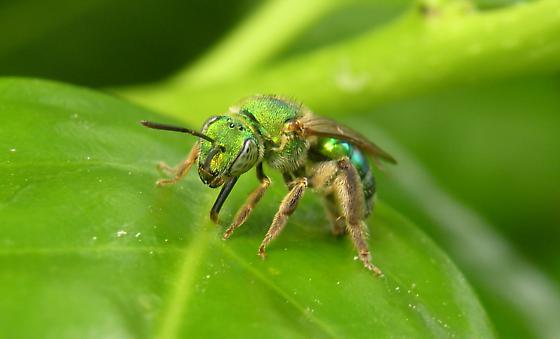Today I am posting on behalf of one of our undergrads, Tyler Connine. He is a pre-med biochemistry major at University of Maryland with a unique awareness of the natural world. Tyler is part of our ongoing Nosema project which is focused on the examination of individual bees for Nosema spores. Aside from his growing interest in honeybees, Tyler has also shown some curiosity towards native bee species. This is his blog entry.
Know Your Local Pollinators!
Most people are aware of the importance of pollinators in plant reproduction. But do you know about your native pollinators?
The temperate climate of Maryland makes spring and summer times of explosive growth for the local plant population, and most of these (about 90%) require pollinators to reproduce. The ecology of Maryland is extremely diverse, with Maryland being home to about 400 species of bees alone. These insects are from 5 common families, reviewed below.
Maryland Bee Families
Apidae
The Apidae family is the largest family of bees and includes honeybees, which are not native to the United States. Some of the native bees from this family include bumble bees, carpenter bees, and a group of bees called cuckoo bees
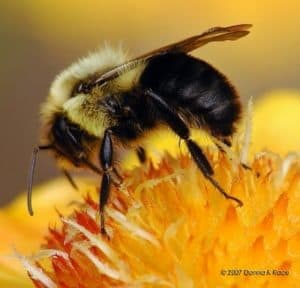
http://bugguide.net/images/raw/8RHHSROZ
KRDZ0R3Z6RLHQRFZQRLH6ROLMZZH0Z
DL6RALIZVLMZALFLNLLZJZLZPLYLDZ7RJZ
7R6LYLbugguide.net/node/view/347417
Pictured above is a bumble bee (Bombus impatiens), a fuzzy, ground nesting species of bee. This Maryland native bee forms small, seasonal colonies and normally feeds on a consistent patch of flowers each day.

http://www.fs.fed.us/wildflowers/pollinators/
pollinator-of-the-month/images/carpenterbees/
carpenter_bee_penstemon_lg.jpg
Carpenter bees (Xylocopinae virginica), pictured above, are a species of bee very similar to the bumble bee. The main physiological difference is their relatively hairless black abdomen. They also differ in their nesting habits and, as the name suggests, these bees nest by tunneling into wooden structures. They do not ingest the wood, but instead discard the extra wood pulp or use it to form partitions inside the nest.
Halictidae
This family contains some very colorful bee species, some with metallic-colored bodies. These species tend to nest in the ground and feed on plant pollen.
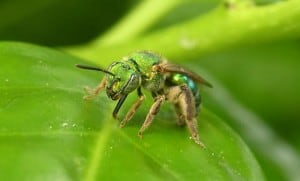
bgimage
Above is a picture of one of a female Agapostemon sericeus, a native member of the Halictidae family.
Andrenidae
Species from this family of bees are known as miner bees and nest underground. They can be generally identified by a velvety patch of hair between their eyes and antennae. These bees are usually the earliest to emerge in spring and are known for pollinating azaleas and apples. Many of these bees are solitary, although some species form colonies. Below is a picture of a typical mining bee.
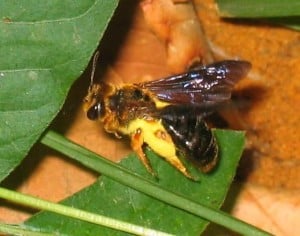
Pictured above is Andrena obscuripennis, a mining bee native to Maryland.
Megachilidae
This family includes mason bees and leaf-cutter bees. These bees tend to carry pollen on their bellies as opposed to pollen sacs on their legs or abdomen. Most species nest in holes in wood.
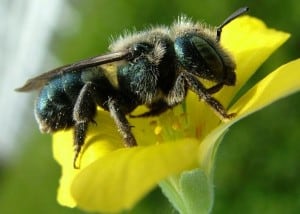
Bee_Diversity/LinkPhotos2/
Osmia_collinsiae.jpg
Blue orchard bees (Osmia lignaria), pictured above, are a species of mason bees, which reside in natural holes in wood, as they are not capable of drilling their own holes. These bees are quite docile and are recommended for urban bee keeping. When building nests mud is used to create partitions inside of the wooden hole, and each level of the partition is filled in by pollen and nectar. The females are known to collect this nectar and pollen from the nearest flowers, unlike honey bees that are known to fly miles away to collect supplies. These bees are used quite often for pollination of apple orchards.
Colletidae
These are a family of solitary bees which nest in the pithy stems of plants. They are generally nearly hairless and can be mistaken easily for wasps.

While most species belonging to this family are hairless, pictured above is a species that does have hair, Colletes americanus, a Maryland native species of Colletidae.
Who cares?
In the modern agriculture industry it may seem that the local pollinators are of little significance. Honeybees can be rented from local beekeepers to pollinate crops, and many farms have begun keeping a honey bee hive as a standard practice. However, a recent study shows that local pollinators may be much more effective at the pollination of crops. Crop systems worldwide were studied, and in all cases of pollination by wild insects fruit set was increased.1 This was not so in the systems pollinated by honey bees, in which only 14% of the systems pollinated by honey bees showed significantly increased fruit set.1 This suggests that usage of imported or cultured honey bee populations is best supplemented by native pollinators. Therefore better management of wild insects through preservation of natural forage area could increase crop yield!
The take home message from this posting should be that your native pollinators are important. Knowing the major pollinators in your area and engaging in practices to maintain these populations could incur a significant benefit on your local plants. Bee informed!
References
1. Garibaldi, Lucas A., et al. “Wild Pollinators Enhance Fruit Set of Crops Regardless of Honey Bee Abundance.” Science (2013).
